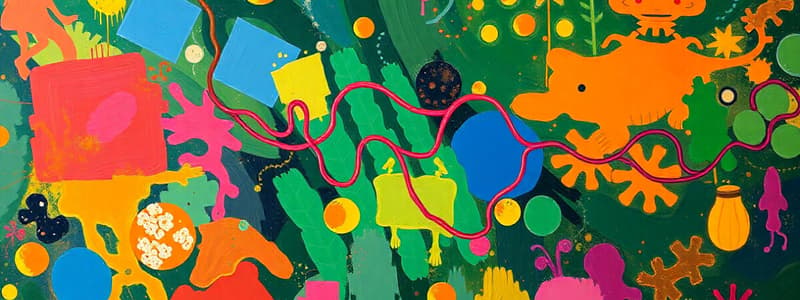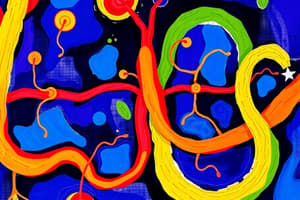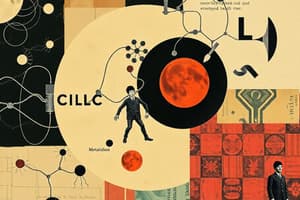Podcast
Questions and Answers
What is one of the primary roles of glucose in metabolism?
What is one of the primary roles of glucose in metabolism?
- It serves solely as a precursor for water synthesis.
- It is an energy-rich fuel for ATP generation via glycolysis. (correct)
- It acts exclusively as a structural component in cells.
- It can only be stored in its monomeric form.
How is the amount of glucose in the blood primarily regulated?
How is the amount of glucose in the blood primarily regulated?
- By external supplementation of glucose only.
- Primarily by the breakdown of triglycerides.
- Through uncontrolled release of insulin.
- Via several processes that involve the production and consumption of glucose. (correct)
Which statement accurately describes glucose as an osmolyte?
Which statement accurately describes glucose as an osmolyte?
- It serves exclusively as a waste product in metabolism.
- It can exist only in liquid form and cannot be polymerized.
- It can be stored in polymeric forms like glycogen and starch. (correct)
- It is not involved in cellular osmoregulation.
Which of the following represents a high-energy, long-term energy storage system in organisms?
Which of the following represents a high-energy, long-term energy storage system in organisms?
What is the significance of the negative ΔG value in the glucose metabolism equation?
What is the significance of the negative ΔG value in the glucose metabolism equation?
What is the primary product of glycogen degradation through phosphorolysis?
What is the primary product of glycogen degradation through phosphorolysis?
Which metabolite is a known activator of hexokinase activity?
Which metabolite is a known activator of hexokinase activity?
Which of the following enzymes converts phosphoenolpyruvate to pyruvate?
Which of the following enzymes converts phosphoenolpyruvate to pyruvate?
Which molecule inhibits phosphofructokinase-1 (PFK-1) activity?
Which molecule inhibits phosphofructokinase-1 (PFK-1) activity?
Which of the following statements about the glycolysis regulation is true?
Which of the following statements about the glycolysis regulation is true?
What is the consequence of decreased NADPH levels in relation to glutathione?
What is the consequence of decreased NADPH levels in relation to glutathione?
How does low NADPH levels affect individuals with G-6-PD deficiency?
How does low NADPH levels affect individuals with G-6-PD deficiency?
What is believed to be the mechanism by which Plasmodium is killed?
What is believed to be the mechanism by which Plasmodium is killed?
Which substance is crucial for reducing oxidative stress by maintaining reduced glutathione levels?
Which substance is crucial for reducing oxidative stress by maintaining reduced glutathione levels?
What happens to H2O2 levels when NADPH levels decrease?
What happens to H2O2 levels when NADPH levels decrease?
What compound inhibits the HMP pathway?
What compound inhibits the HMP pathway?
What is reduced glutathione primarily composed of?
What is reduced glutathione primarily composed of?
Which enzyme is responsible for the conversion of hydrogen peroxide in the presence of glutathione?
Which enzyme is responsible for the conversion of hydrogen peroxide in the presence of glutathione?
In red blood cells (RBCs), what is the primary source of NADPH?
In red blood cells (RBCs), what is the primary source of NADPH?
What happens to the HMP when NADPH levels are low?
What happens to the HMP when NADPH levels are low?
What is the role of glutathione reductase in the context of oxidative stress?
What is the role of glutathione reductase in the context of oxidative stress?
Which of the following is NOT a component of the glutathione mechanism?
Which of the following is NOT a component of the glutathione mechanism?
In the context of the HMP, what is the fate of NADPH?
In the context of the HMP, what is the fate of NADPH?
What is the primary reason G6PD cannot be continually synthesized?
What is the primary reason G6PD cannot be continually synthesized?
Which pathway is associated with the production of NADPH?
Which pathway is associated with the production of NADPH?
What role does glutathione play in the metabolic process described?
What role does glutathione play in the metabolic process described?
What happens to NADPH during the interaction with Pamaquin in red blood cells?
What happens to NADPH during the interaction with Pamaquin in red blood cells?
What compound is involved in the nonenzymatic reduction alongside NADPH?
What compound is involved in the nonenzymatic reduction alongside NADPH?
Why is the reduction of oxidized pamaquin significant in red blood cells?
Why is the reduction of oxidized pamaquin significant in red blood cells?
What is the relationship between NADPH and glutathione in the described metabolic pathway?
What is the relationship between NADPH and glutathione in the described metabolic pathway?
What role does glutathione peroxidase play in the metabolic process?
What role does glutathione peroxidase play in the metabolic process?
What is the overall equation of glycolysis?
What is the overall equation of glycolysis?
Which of the following phases of glycolysis involves energy consumption?
Which of the following phases of glycolysis involves energy consumption?
In glycolysis, how many molecules of ATP are generated?
In glycolysis, how many molecules of ATP are generated?
How much of the total energy in glucose is harvested during glycolysis?
How much of the total energy in glucose is harvested during glycolysis?
What is the primary role of hexokinase in glycolysis?
What is the primary role of hexokinase in glycolysis?
Which step in glycolysis represents the first committed step?
Which step in glycolysis represents the first committed step?
Which of the following statements about RBCs and glycolysis is true?
Which of the following statements about RBCs and glycolysis is true?
What is the change in free energy ($ riangle G$) for the overall glycolysis reaction?
What is the change in free energy ($ riangle G$) for the overall glycolysis reaction?
At which stage of glycolysis is NADH produced?
At which stage of glycolysis is NADH produced?
Which enzyme is specifically highlighted as playing a key role in regulating glycolysis?
Which enzyme is specifically highlighted as playing a key role in regulating glycolysis?
Flashcards
Glycolysis
Glycolysis
The breakdown of glucose to produce energy (ATP).
Glucose
Glucose
A major energy source for organisms.
Embden-Meyerhof Pathway
Embden-Meyerhof Pathway
Another name for glycolysis.
Energy Storage
Energy Storage
Signup and view all the flashcards
Blood Glucose Regulation
Blood Glucose Regulation
Signup and view all the flashcards
Glycolysis
Glycolysis
Signup and view all the flashcards
Preparatory phase (Glycolysis)
Preparatory phase (Glycolysis)
Signup and view all the flashcards
Payoff phase (Glycolysis)
Payoff phase (Glycolysis)
Signup and view all the flashcards
Activation energy
Activation energy
Signup and view all the flashcards
Pyruvate
Pyruvate
Signup and view all the flashcards
ATP
ATP
Signup and view all the flashcards
NADH
NADH
Signup and view all the flashcards
Irreversible step (Glycolysis)
Irreversible step (Glycolysis)
Signup and view all the flashcards
Glucose transporters (GLUT)
Glucose transporters (GLUT)
Signup and view all the flashcards
Hexokinase
Hexokinase
Signup and view all the flashcards
Glucokinase/Hexokinase
Glucokinase/Hexokinase
Signup and view all the flashcards
Phosphofructokinase (PFK-1)
Phosphofructokinase (PFK-1)
Signup and view all the flashcards
Pyruvate Kinase
Pyruvate Kinase
Signup and view all the flashcards
Glycolysis Regulation
Glycolysis Regulation
Signup and view all the flashcards
Glycogen Phosphorolysis
Glycogen Phosphorolysis
Signup and view all the flashcards
HMP role in RBCs
HMP role in RBCs
Signup and view all the flashcards
NADPH source
NADPH source
Signup and view all the flashcards
NADPH function
NADPH function
Signup and view all the flashcards
Reduced Glutathione
Reduced Glutathione
Signup and view all the flashcards
Glutathione Peroxidase
Glutathione Peroxidase
Signup and view all the flashcards
Oxidative Stress
Oxidative Stress
Signup and view all the flashcards
HMP regulation
HMP regulation
Signup and view all the flashcards
Glutathione system
Glutathione system
Signup and view all the flashcards
NADPH role in malaria
NADPH role in malaria
Signup and view all the flashcards
G6PD deficiency
G6PD deficiency
Signup and view all the flashcards
Oxidative stress
Oxidative stress
Signup and view all the flashcards
Reduced glutathione (GSH)
Reduced glutathione (GSH)
Signup and view all the flashcards
Plasmodium killing mechanism
Plasmodium killing mechanism
Signup and view all the flashcards
G6PD deficiency
G6PD deficiency
Signup and view all the flashcards
NADPH production
NADPH production
Signup and view all the flashcards
Pentose pathway
Pentose pathway
Signup and view all the flashcards
Glutathione
Glutathione
Signup and view all the flashcards
Oxidative stress
Oxidative stress
Signup and view all the flashcards
Malaria
Malaria
Signup and view all the flashcards
Reduced glutathione
Reduced glutathione
Signup and view all the flashcards
Pamaquin
Pamaquin
Signup and view all the flashcards
Study Notes
Glycolysis, Gluconeogenesis, and the Pentose Phosphate Pathway
- Glucose is a central molecule in metabolism, acting as both an energy source and a precursor for other molecules
- Glucose is an energy-rich fuel, with the overall reaction of glycolysis producing energy in the form of ATP and NADH:
- C₆H₁₂O₆ + 6O₂ → 6CO₂ + 6H₂O ΔG = -2840 kJ/mol
- Glycolysis (Embden-Meyerhof Pathway) is a multi-step process breaking down glucose into pyruvate
- Two main phases of glycolysis:
- Preparatory phase (energy investment): glucose is activated with energy consumption
- Payoff phase (energy liberation): glucose breaks down with the release of ATP and NADH
- Glycolysis is a key process for energy generation
- Glucose is stored in the form of polymers (starch, glycogen)
- Glycogenolysis breaks down glycogen into glucose
- Glycogenesis converts glucose into glycogen
- Glycolysis and gluconeogenesis share some steps but use different enzymes in certain irreversible steps to allow for controlled directionality
- Gluconeogenesis builds glucose from simpler precursors.
- Pentose Phosphate Pathway (HMP) converts glucose 6-phosphate into ribose 5-phosphate and NADPH.
- Non-oxidative phase recycles pentose phosphates to glucose 6-phosphate
- NADPH is important for reducing reactive oxygen species and for biosynthesis of fatty acids, sterols, etc.
- Ribose 5-phosphate is a precursor for nucleotides, DNA, RNA.
- Glucose dynamics in living organisms is tightly regulated
- Different energy storage systems in organisms - triglycerides (long-term). Glucose and its polymers are enough for 1 or 2 days. ATP, phosphocreatine, and other phosphorylated esters (e.g., acetyl-coA) are dynamic energy-rich forms.
Glucose Dynamics
- Note different energy storage systems in organisms:
- Triglycerides (long-term energy reserves).
- Glucose and starch/glycogen (short-term).
- Glucose is tightly regulated.
Glycolysis (Embden-Meyerhof Pathway)
- Biochemical process breaking down glucose to pyruvate
- 10 distinct steps, with energy release in form of ATP (2 from one glucose molecule; 4 created then 2 needed to start) and NADH
- Preparatory and Payoff phases
- Preparatory phase involves energy input to activate glucose & cleave it.
- Payoff phase releases energy through cleaving glucose and generating ATP and NADH.
- Overall, glycolysis is an essential process.
- Glycolysis is not super efficient in terms of energy generation
- Only 5-6% of total energy is released as ATP from glucose oxidation to CO₂ and H₂O
Glycolysis Steps (Details)
- Glucose enters cells via glucose transporters (GLUT)
- Glucose is marked for degradation by phosphorylation.
- Each step of glycolysis is catalyzed by a specific enzyme. (e.g., hexokinase/ glucokinase, phosphofructokinase, aldolase, etc.)
Glycolysis: Energetics
- Overall equation of glycolysis: Glucose + 2NAD⁺ + 2ADP + 2Pᵢ → 2Pyruvate + 2NADH + 2H⁺ + 2ATP + 2H₂O.
- Glycolysis is essential and irreversible due to a net decrease in free energy.
- Glycolysis is relatively inefficient.
Gluconeogenesis (Carbohydrate Synthesis from Simple Precursors)
- Biosynthesis of glucose from non-carbohydrate precursors (e.g., pyruvate, lactate, amino acids, glycerol).
- Reversal of some steps; others must be bypassed due to the highly exergonic nature of glycolysis
- Important in maintaining blood glucose levels, especially during fasting.
Gluconeogenesis: Enzymatic Steps
- Reverses some enzymatic steps in glycolysis that are highly irreversible.
- Steps 10, 6, 3 are bypassed
Gluconeogenesis: Energetics
- Requires energy input in the form of ATP and GTP.
- Gluconeogenesis is energetically costly in terms of ATP and GTP usage.
Gluconeogenesis: Pathway
- Breakdown of simple precursors, such as lactate for example.
- Important that glucose is generated inside of the cell, then released from the cell.
Pentose Phosphate Pathway (HMP)
- Generates NADPH and ribose-5-phosphate
- Important for biosynthesis of fatty acids, sterols, & nucleotides.
- The pathway is flexible in generating important forms of glucose
Oxidative "Stress" and the Role of Glutathione
- Reactive Oxygen Species (ROS).
- Important role of the pentose phosphate pathway (HMP) in maintaining the balance between oxidizing and reducing compounds.
- Anti-oxidant properties of glutathione
- Necessary for reducing reactive oxygen species (ROS).
- The HMP produces NADPH and is necessary for reducing glutathione.
Polyol Pathway
- Alternative pathway to glycolysis utilizing cells lacking sorbitol dehydrogenases.
- Excess glucose accumulation and buildup of sorbitol leads to osmotic damage
Drugs and Diseases
- Diseases related to the malfunction of pathways (i.e., galactosemia, cancer, beri-beri, malaria, diabetes).
- Drugs impacting pathways (i.e., FdG imaging agents, thiamine, pamaquin)
Metabolic Characteristics of Glycolysis
- Regulation of glycolysis (well-fed state vs fasting)
- Involves various enzymes, regulatory molecules, and hormones.
Studying That Suits You
Use AI to generate personalized quizzes and flashcards to suit your learning preferences.




